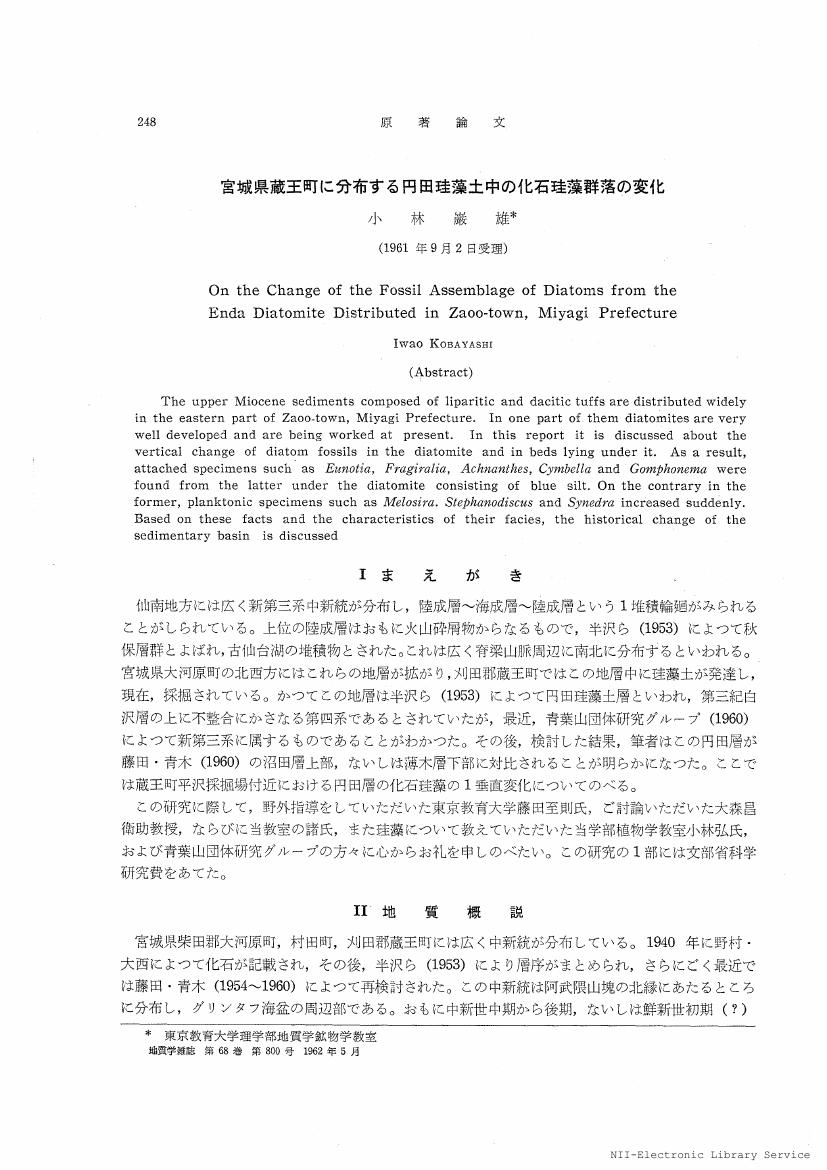3 0 0 0 新潟地域における新第三系の層序と新第三紀古地理
新生代の新潟地域に分布する新第三系〜下部更新統の層序の資料を整理し, 対比を再検討した。これらの資料に加えて, 堆積相・化石相に基づき, 8つの時代の古地理図を描き, 古環境の概略を論じた。1. 前期中新世(18 Ma)の三川期:佐渡・岩船-津川地域で陥没盆地として発生した陸上の堆積盆に主に安山岩〜流紋岩の火砕岩類と砕屑岩類が堆積した。冷涼な気候であった。2. 前期/中期中新世(16-15 Ma)の津川-七谷期:著しい海進が広域に起こり, 暖流で洗われた多島海の海域が出現した。気候は温暖となり, 暖流系の各種生物群が生息した。後半に下部浅海ないし半深海へと変わった。3. 中期中新世の中頃(14-13 Ma)とその後半(11-9 Ma)の寺泊期:海が深くかつ拡大し, 温帯水域の海洋へと推移した。当時深海下にあった頸城地域に広大な海底扇状地が成長し, 佐渡〜新潟油田地域の北部では珪藻質軟泥が厚く堆積した。さらに, 玄武岩質の海底火山が佐渡地域などで噴出した。4. 後期中新世(7 Ma)の椎谷期:堆積盆の東側に当たる脊梁地域および海域全体に起きた大きな変動は, 古海洋に様ざまな変化をもたらした。地球規模の変動もこの時代に起こり, その影響もうけて海洋・陸上生物群が変化した。とくに, 北北東-南南西方向のトラフが成長し, 東側がらもたらされた粗粒堆積物で埋積された。5. 前期鮮新世(4 Ma)の西山期前半:脊梁山地側の隆起が進行したが, 一方海盆は再び拡大し, 暖流が流入する縁海としての日本海が顕在化した。海底の火山活動が活発化した地域もあった。6. 後期鮮新世/前期更新世初頭(3-1.5 Ma)の西山期後半〜灰爪期前半:東側の隆起と南側の海退が急速に進行し, 陸地が広く現れた。寒流の影響も受けはじめ。南方系の生物群とともに北方系の生物群が渡来した。海底の一部が隆起帯を形成したり, 佐渡・弥彦地域などでは陸地が出現した。7. 前期更新世(1 Ma)の灰爪期後半:新潟堆積盆地の中部・現在の日本海域を除いて, 新生代の堆積盆が陸化し, 扇状地や海岸平野が出現した。海水準変動による海進と海退が繰り返され, 暖期には南方系の海棲動物が北上した。
1 0 0 0 OA 宮城県蔵王町に分布する円田珪藻土中の化石珪藻群落の変化
- 著者
- 小林 巌雄
- 出版者
- 一般社団法人 日本地質学会
- 雑誌
- 地質学雑誌 (ISSN:00167630)
- 巻号頁・発行日
- vol.68, no.800, pp.248-254, 1962-05-25 (Released:2008-04-11)
- 参考文献数
- 12
1 0 0 0 須賀昭一先生のご逝去を悼む
- 著者
- 小林 巌雄 後藤 仁敏
- 出版者
- 化石研究会
- 雑誌
- 化石研究会会誌 (ISSN:03871924)
- 巻号頁・発行日
- vol.26, no.1, pp.p42-43, 1993-06
- 著者
- 小林 巌雄
- 出版者
- 日本貝類学会
- 雑誌
- 貝類学雑誌Venus : the Japanese journal of malacology (ISSN:00423580)
- 巻号頁・発行日
- vol.39, no.3, pp.178-185, 1980-11-30
The internal shell structure of Bentharca asperula (DALL) is examined under a scanning electron microscope. Living specimens were collected at the sea bottom off Hachijo Island, Tokyo (33°03.5'N ; 140°45.3'E). The shell mainly is composed of outer and inner calcareous shell layers. The former shell layer is made of crossed lamellar structure and the latter is of complex crossed lamellar structure. The crossed lamellar structure of this species is same to the typical crossed lamellar structure of the other Arcoids. Next, there are several different types of the aggregation of crystallites in the complex crossed lamellar structure. The complex crossed lamellar structure of this species is characterized by the parallel arrangement of elongate rod-like crystallites which is inclined toward the ventral margin. Tubules penetrate outer and inner calcareous layers. The openings distribute at the region of inner shell layer on an inner shell surface. The mineral kind of crystallites of both layers is aragonitic crystal. The form of crystallites is elongate rod. The internal shell structure of Bentharca asperula, one of deep sea molluscs, is not special, but is common to one of the other species of Arcoids.
1 0 0 0 新潟県,第四系産長鼻類化石3標本の再検討
- 著者
- 高橋 啓一 小林 巌雄
- 出版者
- 地学団体研究会
- 雑誌
- 地球科學 (ISSN:03666611)
- 巻号頁・発行日
- vol.40, no.1, pp.39-46b, 1986-01-25
- 被引用文献数
- 2
Three elephant molars from the Pleistocene were found in Niigata Prefecture and reported by MATSUMOTO et al. (1968) have been re-examined. These molars were identified by MATSUMOTO et al. (1968) as Loxodonta (Palaeoloxodori) yabei, L. (P.*) tokunagai junior (=Palaeoloxodon naumanni), but morphological and stratigraphical studies have identified these molars as being from an archtipal mammoth. Specifically, this morphological study identified the Monzen specimen as Mammuthus protomammonteus. In comparison with the measurement of molars of the genus Mammuthus in Europe by MAGLIO (1973), the Monzen specimen is similar to M. armeniacus. This shows that the progression of stages in the development of genus Mammuthus is similar to Europian counterpart. Meanwhile a geological survey has revealed that the Mitama specimen occured in a SK030 bed (1.30 m. y. B. P.), which is the key bed of the most upper part of the middle Formation in the Uonuma Group. Therefore the importance of this specimen to discussion is that the meridionalis type shifted into the armeniacus type in Japan.


